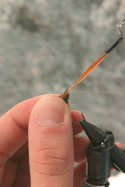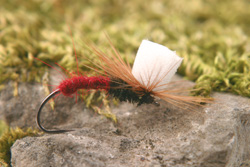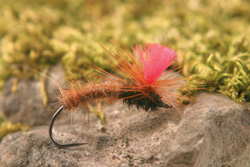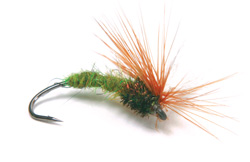This is a fly that has to be in every angler’s kit. The Klinkhammer is one of the most-successful flies ever devised and like most effective patterns; its success comes from close study of trout feeding behaviour.
Hans van Klinken from Holland created the Klinkhammer after much experience on the rivers of Scandinavia. His mentor was the Swedish guru Kenneth Bostrom. An extremely able fisher who originated a fly called the Rackelhammer to imitate the hatching sedge. This fly was made entirely from buff-coloured poly fibres with projecting stub wings tied flat in the form of a cross. It floated when cast upstream but when tweaked sank just below the surface. The idea was to represent the movements of hatching caddis or sedge flies.
Hans adapted this idea using the form of the parachute fly but bending the hook near the eye so that the thorax would float and the abdomen would sink. The Klinkhammer rides the water half submerged unlike conventional dry flies that are supported by their tails. Specialised, kinked Klinkhammer hooks are now available.
I once watched Hans tying the fly. The trick is to tie the wing post, the peacock herls and the hackle feather close together; wind the buff Flyrite dubbing around the hook bend, wind the peacock thorax, then tie off. That leaves the hackle to be wound. Here comes the clever bit: Tilt the hook forward in the vice, tie in Spiderweb thread around the base of the wing post, wind the hackle three turns and then wind the Spiderweb through the hackle, tie off and clip the hackle tip.
Many experienced anglers regard the Klinkhammer as the best all-round trout fly for river fishing. In stillwater circles, its huge potential is only now being realised.
Dressing
Hook: Scorpion Living Larvae or Partridge Klinkhammer 15BN,
sizes to suit insect being imitated.
Silk: Tan
Body: Dubbed fur, colour to suit insect being imitated
Thorax: Peacock herl
Hackle: Cock, colour to suit insect being imitated
Post: Antron, normally white
Tying the Klinkhammer
 |
| 1. Take the silk in close-touching turns to the point just above the barb of the hook. |
|
 |
| 2. Tie the post material along the shank, stopping roughly 5mm before the eye of the hook. |
|
 |
| 3. Form the dubbing around the silk and create a tight rope as you want this to sink below the surface meniscus. |
|
 |
| 4. Create the body using close-touching turns. Stop 3mm from the post and tie in the cock hackle. |
|
 |
| 5. Tie in the cock hackle at the base of the post and wrap the silk eight times around the base of the wing post. |
|
 |
| 6. Take the silk to the eye. Form the thorax with the herl, take it to the eye of the hook, tie in and finish off. |
|
 |
| 7. Wrap the hackle three times around the base of the post, over the wraps you applied in step 5. |
|
 |
| 8. Sweeping the fibres of the hackle rearwards, bring the hackle forward and offer it up to the eye. |
|
 |
| 9. Tie in and trim the excess. Carefully finish with three half-hitches, Varnish and allow to dry. |
|
Variations
The variations on this pattern are too numerous to even contemplate listing. Here are two that stand out from the crowd:
 |
| Foam Hammer. |
 |
| Pink Hammer. |
Pink Hammer
The highly-visible post means that it can be seen from a long way off, and it stands out in low-light conditions. Instead of using a conventional colour for the wing post, try bright pink, and green works well too. Remember the fish see it from underneath, so they can’t see the wing post.
Foam-hammer
This is an excellent adaptation of Hans’ pattern. Substitute the post material with a strip of foam – which is virtually unsinkable and guaranteed to float. This is ideal for fishing the New Zealand method, as it will support the extra weight of a sneaky nymph presented underneath.
Fishing Tips
The Klinkhammer is a very-effective emerger pattern. Look at the hatch on your local water and try to match the predominant colours for success. Fish it as you would a conventional dry fly. Although it was designed for rivers, it works wherever you have fish that feed on emerging insects.
Fish it motionless; take up the slack just keeping in contact with it. Do not retrieve it – small, emerging invertebrates don’t move very quickly!
New Zealand Style
If the fish are coming short, try a New Zealand dropper. Tie a small nymph to a length of 8-12in tippet. Tie this to the bend of the hook with an improved clinch knot. Fish it as you would normally use a dry fly, watch the fly as a bite indicator and if it disappears, strike – devastatingly effective.


















